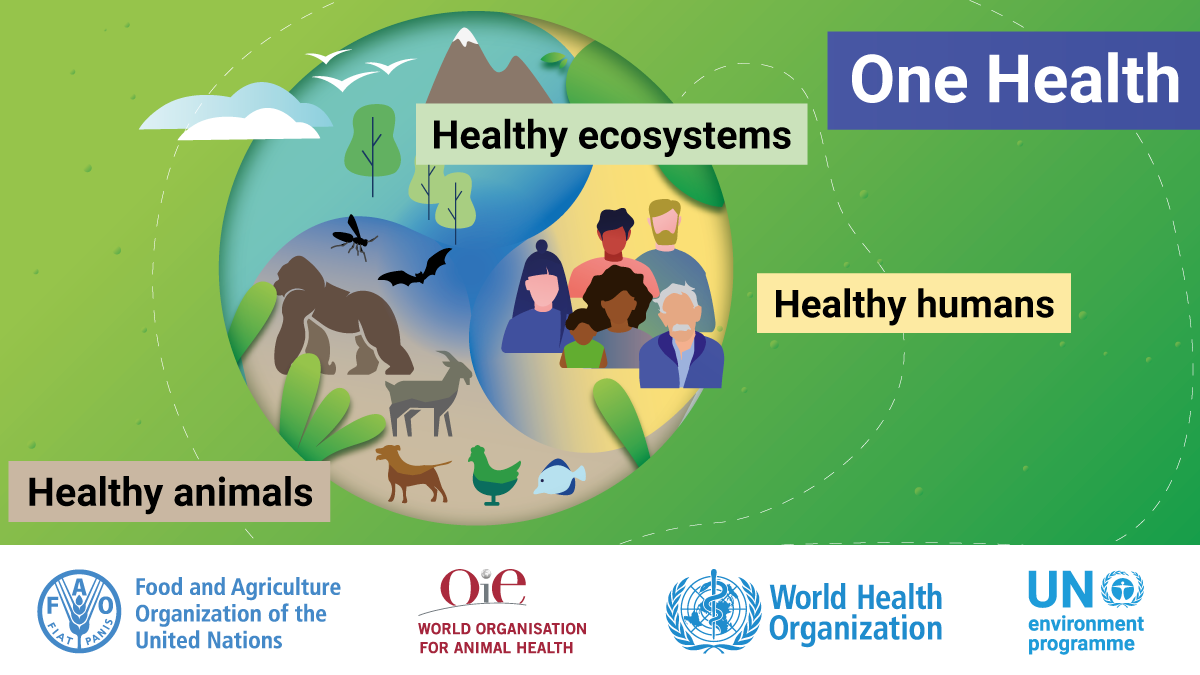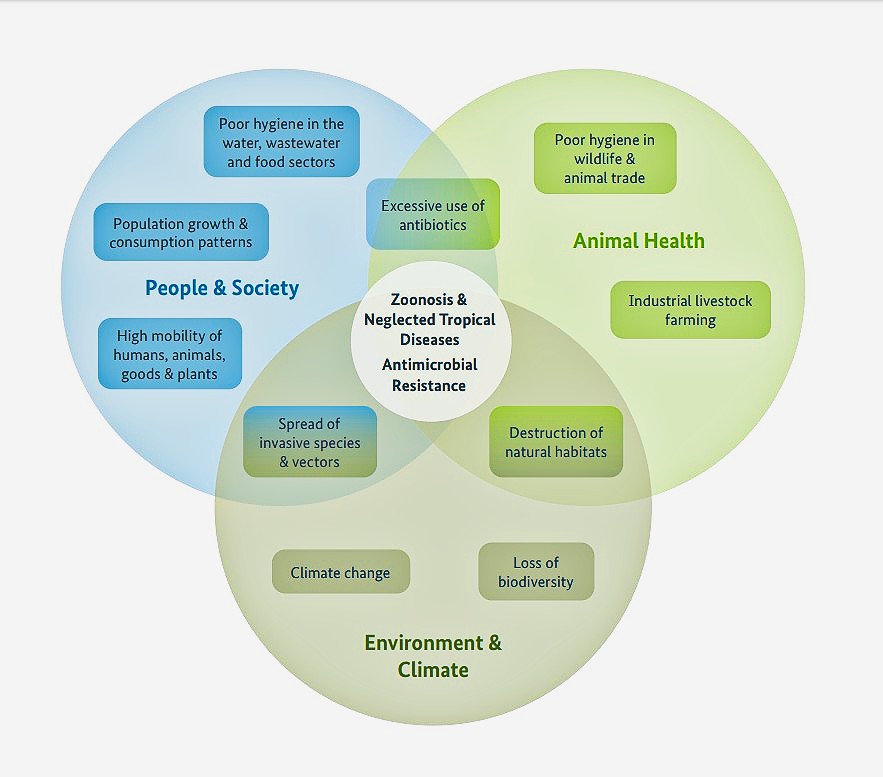In the 20th and early 21st centuries, the world has been forced to deal with multiple zoonotic disease outbreaks and two notable pandemics including the 1918 Influenza debacle. At this writing, with COVID-19 continuing to be a significant challenge, monkeypox is now also labeled a “Public Health Emergency of International Concern”. And throughout human history, there have been infectious diseases that have had huge impacts on mankind, from which some valuable lessons have been learned. But at other times, lessons were missed, in some cases because of a failure to interpret what might have been done to ameliorate the impact.
Writer and philosopher George Santayana said, “Those who cannot remember the past are condemned to repeat it.” To that wisdom, we should add that if we ignore or fail to recognize visionary new thinking on ways to contain, and prevent an epidemic or pandemic, we shall have lost crucial opportunities to avoid immense suffering and loss.
The saga of the One Health concept is a case in point. Its history is detailed in “One Medicine – One Health: An Historic Perspective” (the link will bring you to the document and it is also available on the One Health Initiative website).
Looking at how this concept has developed over time brings home a simple but major truth: It is clear that from its early formulations in past centuries until today, the advantages of a One Health approach have yet to be fully understood and taken up by those in positions to do so.
A brief overview of the chronology and milestones will help to better understand how we got here, where we are today and a way forward.
The road to a fully developed One Health concept
In the mid-1850s, over 150 years ago, physician Dr. Rudolph Virchow, who is often called the “father of Cellular Pathology”, was also prescient in saying unequivocally:
“Between animal and human medicine there are no dividing lines- nor should there be. The object is different but the experience obtained constitutes the basis of all medicine.”
Physician Dr. William Osler, referred to as the “father of Modern Medicine” and founder of veterinary pathology, was a trailblazer in the latter half of the nineteenth century by strengthening the understanding of the links between human and animal pathology.
By the twentieth century two exceptional veterinarians Drs. Calvin Schwabe and James Steele became vocal champions of the evolving One Health concept.
Steele was the founder of the Veterinary Division of the U.S. Centers for Disease Control and Prevention, and in much of Steele’s communications he referred to “one world, one medicine, one health.”
Schwabe was a major thinker and writer in pursuing comparative medicine and translational research. He made the following powerful observation:
“Many of the most significant breakthroughs in improving human health have been closely associated with observations and experiments on animals other than man.”
In the twenty-first century, physician Dr. Ronald Davis, as President of the American Medical Association (AMA) succeeded in launching a process of institutional restructuring of that organization, broadening its mandate: In 2007, he guided AMA to adopt a resolution calling for increased collaboration between the human and veterinary medical communities.
In recent decades, this process of institutional restructuring has accelerated, as the human and animal medical professions have been joined with experts in the environment, properly broadening the definition of “One Health”.
Where One Health is today
One Health is now widely recognized as encompassing collaborative efforts of multiple disciplines working locally, nationally, and globally to obtain optimal health for people, animals, plants, and the environment. And the UN system has adopted a unified definition to coordinate and guide the work of four major agencies:

It has also meant growing cadres of advocates around the world, and international bodies acknowledging the importance of One Health, leastways in words and resolutions. Among them, Dr. Fauci stands out as a major champion of One Health.
My bipartisan one health bill would help make sure preparedness efforts meet the needs of all people, all ages and all communities. Even Dr. Fauci himself recently highlighted the importance of one health with @StephenAtHome. Check out the clip here: https://t.co/en2FVaGlLt
— Senator Tina Smith (@SenTinaSmith) March 18, 2021
As health systems grow and modernize around the world, there is a rise in institutional adoption of One Health as a policy goal together with guidelines for implementation. As Richard Seifman pointed out in a recent article, at the national level, the growing number of countries adopting One Health Strategic Action Plans is of great significance.
The One Health Commission provided a useful compilation of currently available information, which shows that 21 countries have adopted such plans, mostly in SouthEast Asia (5 countries, including Bangladesh, Thailand and Vietnam) and in Africa (15 countries, including Kenya, Tanzania and Nigeria).
Behind these developments, you find various actors at national and international level in the West. Among the leading bilateral donors in the context of One Health, the United States stands out with the programme of the United States Agency for International Development (USAID) on Emerging Pandemic Threats (EPT), launched in 2005.
Within the framework of the EPT programme, the PREDICT project has been searching for unknown pathogens and supporting training for the monitoring of zoonotic pathogens. The follow-on programme STOP Spillover was commissioned and endowed with 100 million US dollars.
Another active supporter of One Health is the United Kingdom, which launched a programme for more than 220 million pounds in 2019, and thus is one of the most important donors in the field of fighting Neglected Tropical Disease (NTDs).
France is also very active. For example, ANSES, the French Agency for Food, Environmental and Occupational Health and Safety, is also coordinating the One Health European Joint Programme (EJP) (2018-2023), which brings together 39 partners from 19 European countries.
Here is a recent video providing an edited synopsis of a One Health European Joint Programme side event held on June 22 at the ONE 2022 Conference, a four-day meeting held in Brussels with a scientific programme that examined food and feed safety from the broader perspective of sustainable food systems, focusing on the need to implement a “One Health – One Environment” approach and exploring possible developments of risk assessment science.
The ANSES laboratories’ research teams are participating in 17 of the 23 research projects selected within the framework of the EJP’s projects, working on a range of issues, from vector-borne diseases, including those transmitted by ticks and mosquitoes to the spread of insect vectors of plant diseases due to climate change, environmental factors posing a risk to bee health and much more – including the impact of climate change on health, especially that of workers.
Germany has not stayed behind. Starting in 2021, the German Federal Ministry of Economic Cooperation and Development (BMZ) has announced it will allocate each year up to €150 million for what it defines as its “Initiative area One Health in development cooperation” with the overall policy goal of promoting adoption of the One Health concept in developing countries and emerging economies, or, to use BMZ’s own words:
“anchoring One Health as a holistic, trans-sectoral approach in international development cooperation together with other partners and developing it further”.
The aim is to strengthen health systems with regard to the prevention, early diagnosis and containment of infectious diseases, building on Germany’s wide range of partners in the international development community, from UN agencies like WHO and FAO to universities and research laboratories.

Lobbying for an international One Health body is proceeding with the support of France and Germany. Other countries actively engaged in this field are Canada, Sweden, Norway and Switzerland.
But much more needs to be done. Hopefully the good intentions will be followed in deeds reflected in funds for research, policies and programs. And hopefully, the efforts will be sustained.
There is a window of opportunity to avoid failing to learn from our past and to be open to a One Health approach, which though challenging, will reap untold rewards. Not least among them, it will help us avoid the worst of the next pandemic, most likely to be coming out of the zoonosphere just like COVID-19.
With the contribution of Richard Seifman, JD, MBA and Claude Forthomme, MA
Editor’s Note: The opinions expressed here by the authors are their own, not those of Impakter.com — In the Featured Photo: Rudolf Virchow, 1821-1902 Source: Famous Scientists, the Art of Genius










